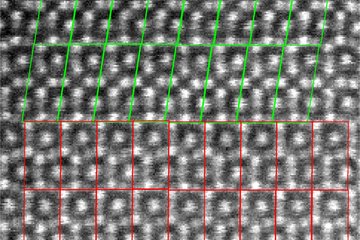All genres
141.
Poster
Composition analysis of InGaN quantum wells by STEM-HAADF. 15th European Microscopy Congress, Manchester Central, UK (2012)
142.
Poster
Quantitative measurement of composition fluctuations in InGaN quantum wells. 15th European Microscopy Congress, Manchester Central, UK (2012)
143.
Poster
Semipolar {11-22} AlN surfaces: Morphology and electronic properties. International Conference on Extended Defects in Semiconductors, Thessaloniki, Greek (2012)
144.
Poster
Ab-initio based comparitive study of In incorporation and surface segregation on III- and N-face {0001} InGaN surfaces. SINOPLE mid-term meeting, Berlin, Germany (2011)
145.
Poster
Quantum-mechanics-based study of multi-scale elastic properties of hierarchical biocomposites. Prospects of bionics for functional Materials Science, Montan University Leoben, Leoben, Austria (2010)
146.
Poster
Ab initio based study of multi-scale elastic properties of hierarchical biocomposites. Psi_k Conference 2010, Berlin, Germany (2010)
147.
Poster
Surface Thermodynamics of (11-22) and (11-2-2) Semipolar AlN Surfaces. International Workshop on Nitride Semiconductors, Tampa, FL, USA (2010)
148.
Poster
Arthropod cuticle: A biological multi-functional composite used as template for nano-to-macro-scale hierarchical modeling. Materials Science and Engineering 2010, Darmstadt, Germany (2010)
149.
Poster
A multiscale study of the Hydrogen enhanced local plasticity (HELP) mechanism. IWoM3 2009 - International Workshop on Multiscale Materials Modeling, Berlin, Germany (2009)
150.
Poster
Adatom kinetics on and in III-V semiconductor surfaces. Scientific Advisory Board Meeting 2009, MPIE, Düsseldorf, Germany (2009)
151.
Poster
Hierarchical modeling of the mechanical properties of lobster cuticle from nano‐ up to macroscale: The influence of the mineral content and the microstructure. 4th International Conference on Multiscale Materials Modeling, Tallahassee, FL, USA (2008)
152.
Poster
An ab-initio study of hardness anisotropy of crystalline alpha-chitin. Euromat 2007, Nürnberg,Germany (2007)
153.
Poster
Hardness anisotropy of crystalline alpha-chitin: An ab-initio based conformational analysis. Spring meeting of the German Physical Society (DPG), Regensburg, Germany (2007)
154.
Poster
Nonlinear Elastic Effects in Group III-Nitrides. Mid-term Review Meeting of PARSEM, Berlin, Germany (2007)
155.
Poster
An ab-initio study of hardness anisotropy of crystalline alpha-chitin. International Max-Planck Workshop on Multiscale Modeling of Condensed Matter, Sant Feliu de Guixols, Spain (2007)
156.
Poster
Ab-initio based multiscale calculations of grain boundaries in Aluminium. ESOMAT 2006, Bochum, Germany (2006)
157.
Poster
Exploring the 5D configurational space of grain boundaries in aluminun: An ab-initio based multiscale analysis. MRS Fall Meeting, Boston, MA, USA (2006)
158.
Poster
Ab-initio based multiscale calculations of low-angle grain boundaries in Aluminium. Materials Research Society fall meeting, Boston, MA, USA (2005)
159.
Teaching
Ab-initio based multi-scale approaches to the elasticity of metallic polycrystals and hierarchical biocomposites. Lecture: XI National Congress on Theoretical and Applied Mechanics, Borovets, Bulgaria, September 02, 2009 - September 05, 2009
160.
Teaching
Micromechanics of Metallic Crystals and Fresh Lobster. Lecture: Lecture at MPI für Mikrostrukturphysik, Halle, Germany, 2006











